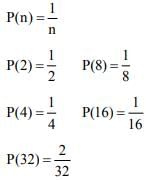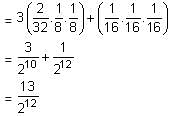JEE Exam > JEE Questions > A biased die is marked with numbers 2, 4, 8, ...
Start Learning for Free
A biased die is marked with numbers 2, 4, 8, 16, 32, 32 on its faces and the probability of getting a face with mark n is 1/n. If the die is thrown thrice, then the probability, that the sum of the numbers obtained is 48, is:
- a)7/211
- b)7/212
- c)3/210
- d)13/212
Correct answer is option 'D'. Can you explain this answer?
Most Upvoted Answer
A biased die is marked with numbers 2, 4, 8, 16, 32, 32 on its faces a...
To find the probability of obtaining a sum of 48 when the biased die is thrown thrice, we need to consider all possible combinations of numbers that add up to 48. Let's break down the problem step by step:
Step 1: Find the possible combinations of numbers that add up to 48.
- Since the maximum number on the die is 32, the sum of three numbers cannot exceed 96.
- To find the combinations, we can start with the largest number (32) and then subtract it from 48 to get the remaining sum.
- Let's consider the cases where the largest number is 32, 16, and 8:
Case 1: Largest number is 32:
- In this case, we need to find all possible combinations of two numbers from the remaining set {2, 4, 8, 16, 32} that add up to 16.
- The possible combinations are: (2, 14), (4, 12), (8, 8)
- However, we need to account for the fact that the die is biased and the probability of getting a particular number is 1/n, where n is the number itself.
- So, the probability of getting (2, 14) is (1/2) * (1/14) = 1/28, the probability of getting (4, 12) is (1/4) * (1/12) = 1/48, and the probability of getting (8, 8) is (1/8) * (1/8) = 1/64.
Case 2: Largest number is 16:
- In this case, we need to find all possible combinations of two numbers from the remaining set {2, 4, 8, 16} that add up to 32.
- The possible combinations are: (2, 30), (4, 28), (8, 24), (16, 16)
- The probabilities are: (1/2) * (1/30) = 1/60, (1/4) * (1/28) = 1/112, (1/8) * (1/24) = 1/192, and (1/16) * (1/16) = 1/256.
Case 3: Largest number is 8:
- In this case, we need to find all possible combinations of two numbers from the remaining set {2, 4, 8} that add up to 40.
- The possible combinations are: (2, 38), (4, 36), (8, 32)
- The probabilities are: (1/2) * (1/38) = 1/76, (1/4) * (1/36) = 1/144, and (1/8) * (1/32) = 1/256.
Step 2: Calculate the total probability.
- Now, we need to add up the probabilities from all the cases to get the total probability of obtaining a sum of 48.
- Total Probability = (1/28) + (1/48) + (1/64) + (1/60) + (1/112) + (1/192) + (1/256) + (1/76) + (
Step 1: Find the possible combinations of numbers that add up to 48.
- Since the maximum number on the die is 32, the sum of three numbers cannot exceed 96.
- To find the combinations, we can start with the largest number (32) and then subtract it from 48 to get the remaining sum.
- Let's consider the cases where the largest number is 32, 16, and 8:
Case 1: Largest number is 32:
- In this case, we need to find all possible combinations of two numbers from the remaining set {2, 4, 8, 16, 32} that add up to 16.
- The possible combinations are: (2, 14), (4, 12), (8, 8)
- However, we need to account for the fact that the die is biased and the probability of getting a particular number is 1/n, where n is the number itself.
- So, the probability of getting (2, 14) is (1/2) * (1/14) = 1/28, the probability of getting (4, 12) is (1/4) * (1/12) = 1/48, and the probability of getting (8, 8) is (1/8) * (1/8) = 1/64.
Case 2: Largest number is 16:
- In this case, we need to find all possible combinations of two numbers from the remaining set {2, 4, 8, 16} that add up to 32.
- The possible combinations are: (2, 30), (4, 28), (8, 24), (16, 16)
- The probabilities are: (1/2) * (1/30) = 1/60, (1/4) * (1/28) = 1/112, (1/8) * (1/24) = 1/192, and (1/16) * (1/16) = 1/256.
Case 3: Largest number is 8:
- In this case, we need to find all possible combinations of two numbers from the remaining set {2, 4, 8} that add up to 40.
- The possible combinations are: (2, 38), (4, 36), (8, 32)
- The probabilities are: (1/2) * (1/38) = 1/76, (1/4) * (1/36) = 1/144, and (1/8) * (1/32) = 1/256.
Step 2: Calculate the total probability.
- Now, we need to add up the probabilities from all the cases to get the total probability of obtaining a sum of 48.
- Total Probability = (1/28) + (1/48) + (1/64) + (1/60) + (1/112) + (1/192) + (1/256) + (1/76) + (
Free Test
FREE
| Start Free Test |
Community Answer
A biased die is marked with numbers 2, 4, 8, 16, 32, 32 on its faces a...

There are only two ways to get sum 48, which are (32, 8, 8) and (16, 16, 16).
So, required probability


|
Explore Courses for JEE exam
|

|
Similar JEE Doubts
A biased die is marked with numbers 2, 4, 8, 16, 32, 32 on its faces and the probability of getting a face with mark n is 1/n. If the die is thrown thrice, then the probability, that the sum of the numbers obtained is 48, is:a)7/211b)7/212c)3/210d)13/212Correct answer is option 'D'. Can you explain this answer?
Question Description
A biased die is marked with numbers 2, 4, 8, 16, 32, 32 on its faces and the probability of getting a face with mark n is 1/n. If the die is thrown thrice, then the probability, that the sum of the numbers obtained is 48, is:a)7/211b)7/212c)3/210d)13/212Correct answer is option 'D'. Can you explain this answer? for JEE 2025 is part of JEE preparation. The Question and answers have been prepared according to the JEE exam syllabus. Information about A biased die is marked with numbers 2, 4, 8, 16, 32, 32 on its faces and the probability of getting a face with mark n is 1/n. If the die is thrown thrice, then the probability, that the sum of the numbers obtained is 48, is:a)7/211b)7/212c)3/210d)13/212Correct answer is option 'D'. Can you explain this answer? covers all topics & solutions for JEE 2025 Exam. Find important definitions, questions, meanings, examples, exercises and tests below for A biased die is marked with numbers 2, 4, 8, 16, 32, 32 on its faces and the probability of getting a face with mark n is 1/n. If the die is thrown thrice, then the probability, that the sum of the numbers obtained is 48, is:a)7/211b)7/212c)3/210d)13/212Correct answer is option 'D'. Can you explain this answer?.
A biased die is marked with numbers 2, 4, 8, 16, 32, 32 on its faces and the probability of getting a face with mark n is 1/n. If the die is thrown thrice, then the probability, that the sum of the numbers obtained is 48, is:a)7/211b)7/212c)3/210d)13/212Correct answer is option 'D'. Can you explain this answer? for JEE 2025 is part of JEE preparation. The Question and answers have been prepared according to the JEE exam syllabus. Information about A biased die is marked with numbers 2, 4, 8, 16, 32, 32 on its faces and the probability of getting a face with mark n is 1/n. If the die is thrown thrice, then the probability, that the sum of the numbers obtained is 48, is:a)7/211b)7/212c)3/210d)13/212Correct answer is option 'D'. Can you explain this answer? covers all topics & solutions for JEE 2025 Exam. Find important definitions, questions, meanings, examples, exercises and tests below for A biased die is marked with numbers 2, 4, 8, 16, 32, 32 on its faces and the probability of getting a face with mark n is 1/n. If the die is thrown thrice, then the probability, that the sum of the numbers obtained is 48, is:a)7/211b)7/212c)3/210d)13/212Correct answer is option 'D'. Can you explain this answer?.
Solutions for A biased die is marked with numbers 2, 4, 8, 16, 32, 32 on its faces and the probability of getting a face with mark n is 1/n. If the die is thrown thrice, then the probability, that the sum of the numbers obtained is 48, is:a)7/211b)7/212c)3/210d)13/212Correct answer is option 'D'. Can you explain this answer? in English & in Hindi are available as part of our courses for JEE.
Download more important topics, notes, lectures and mock test series for JEE Exam by signing up for free.
Here you can find the meaning of A biased die is marked with numbers 2, 4, 8, 16, 32, 32 on its faces and the probability of getting a face with mark n is 1/n. If the die is thrown thrice, then the probability, that the sum of the numbers obtained is 48, is:a)7/211b)7/212c)3/210d)13/212Correct answer is option 'D'. Can you explain this answer? defined & explained in the simplest way possible. Besides giving the explanation of
A biased die is marked with numbers 2, 4, 8, 16, 32, 32 on its faces and the probability of getting a face with mark n is 1/n. If the die is thrown thrice, then the probability, that the sum of the numbers obtained is 48, is:a)7/211b)7/212c)3/210d)13/212Correct answer is option 'D'. Can you explain this answer?, a detailed solution for A biased die is marked with numbers 2, 4, 8, 16, 32, 32 on its faces and the probability of getting a face with mark n is 1/n. If the die is thrown thrice, then the probability, that the sum of the numbers obtained is 48, is:a)7/211b)7/212c)3/210d)13/212Correct answer is option 'D'. Can you explain this answer? has been provided alongside types of A biased die is marked with numbers 2, 4, 8, 16, 32, 32 on its faces and the probability of getting a face with mark n is 1/n. If the die is thrown thrice, then the probability, that the sum of the numbers obtained is 48, is:a)7/211b)7/212c)3/210d)13/212Correct answer is option 'D'. Can you explain this answer? theory, EduRev gives you an
ample number of questions to practice A biased die is marked with numbers 2, 4, 8, 16, 32, 32 on its faces and the probability of getting a face with mark n is 1/n. If the die is thrown thrice, then the probability, that the sum of the numbers obtained is 48, is:a)7/211b)7/212c)3/210d)13/212Correct answer is option 'D'. Can you explain this answer? tests, examples and also practice JEE tests.

|
Explore Courses for JEE exam
|

|
Signup for Free!
Signup to see your scores go up within 7 days! Learn & Practice with 1000+ FREE Notes, Videos & Tests.
























